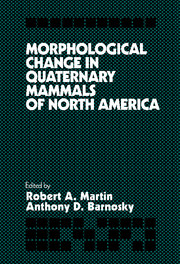Book contents
- Frontmatter
- Contents
- List of Contributors
- Acknowledgments
- 1 Quaternary mammals and evolutionary theory: introductory remarks and historical perspective
- 2 A method for recognizing morphological stasis
- 3 Mosaic evolution at the population level in Microtus pennsylvanicus
- 4 Variogram analysis of paleontological data
- 5 Morphological change in Quaternary mammals: a role for species interactions?
- 6 Rates of evolution in Plio-Pleistocene mammals: six case studies
- 7 Patterns of dental variation and evolution in prairie dogs, genus Cynomys
- 8 Quantitative and qualitative evolution in the giant armadillo Holmesina (Edentata: Pampatheriidae) in Florida
- 9 Evolution of mammoths and moose: the Holarctic perspective
- 10 Evolution of hypsodonty and enamel structure in Plio-Pleistocene rodents
- 11 Patterns of variation and speciation in Quaternary rodents
- 12 Decrease in body size of white-tailed deer (Odocoileus virginianus) during the late Holocene in South Carolina and Georgia
- 13 Short–term fluctuations in small mammals of the late Pleistocene from eastern Washington
- 14 Size change in North American Quaternary jaguars
- 15 Ontogenetic change of Ondatra zibethicus (Arvicolidae, Rodentia) cheek teeth analyzed by digital image processing
- 16 Morphological change in woodrat (Rodentia: Cricetidae) molars
- Index
1 - Quaternary mammals and evolutionary theory: introductory remarks and historical perspective
Published online by Cambridge University Press: 15 December 2009
- Frontmatter
- Contents
- List of Contributors
- Acknowledgments
- 1 Quaternary mammals and evolutionary theory: introductory remarks and historical perspective
- 2 A method for recognizing morphological stasis
- 3 Mosaic evolution at the population level in Microtus pennsylvanicus
- 4 Variogram analysis of paleontological data
- 5 Morphological change in Quaternary mammals: a role for species interactions?
- 6 Rates of evolution in Plio-Pleistocene mammals: six case studies
- 7 Patterns of dental variation and evolution in prairie dogs, genus Cynomys
- 8 Quantitative and qualitative evolution in the giant armadillo Holmesina (Edentata: Pampatheriidae) in Florida
- 9 Evolution of mammoths and moose: the Holarctic perspective
- 10 Evolution of hypsodonty and enamel structure in Plio-Pleistocene rodents
- 11 Patterns of variation and speciation in Quaternary rodents
- 12 Decrease in body size of white-tailed deer (Odocoileus virginianus) during the late Holocene in South Carolina and Georgia
- 13 Short–term fluctuations in small mammals of the late Pleistocene from eastern Washington
- 14 Size change in North American Quaternary jaguars
- 15 Ontogenetic change of Ondatra zibethicus (Arvicolidae, Rodentia) cheek teeth analyzed by digital image processing
- 16 Morphological change in woodrat (Rodentia: Cricetidae) molars
- Index
Summary
The Quaternary period marks the transition from environments populated with fabled, extraordinary creatures such as saber-toothed cats, giant ground sloths, dire wolves, cave bears, woolly rhinos, and mammoths to the more familiar landscapes of modern time. Anatomically modern humans appeared during the late Quaternary. The Quaternary is composed of the Pleistocene epoch, or Ice Ages, which lasted from about 1.7 Ma to 10 ka, and the Holocene epoch, or present interglacial, which begins where the Pleistocene ends and extends to the present. The Quaternary was characterized by dramatic geographic shifts of continental glaciers, accompanied by major transgressions and regressions of sea level. During the height of the last major North American glacial period, the Wisconsinan, much of the continental shelf was exposed and probably represented a vast lowland savannah. Fishermen have recovered proboscidean teeth and bones from the shelf at depths of more than 90 m (Whitmore et al., 1967). Within this dynamic context the geographic ranges of many species of animals and plants expanded and contracted, and a concomitant pattern of originations and extinctions developed.
To evolutionary biologists the Quaternary record represents a vast laboratory, full of natural experiments, in which hypotheses of evolutionary tempo and mode may be examined. The benefits of working in this laboratory are manifold. Modern species are often represented, and their past distributions in some cases often provide important, independent climatic signals in their own right, and in other cases can be tested against independent climate data to ascertain the relative importance of physical perturbations in causing evolutionary events.
- Type
- Chapter
- Information
- Publisher: Cambridge University PressPrint publication year: 1993

